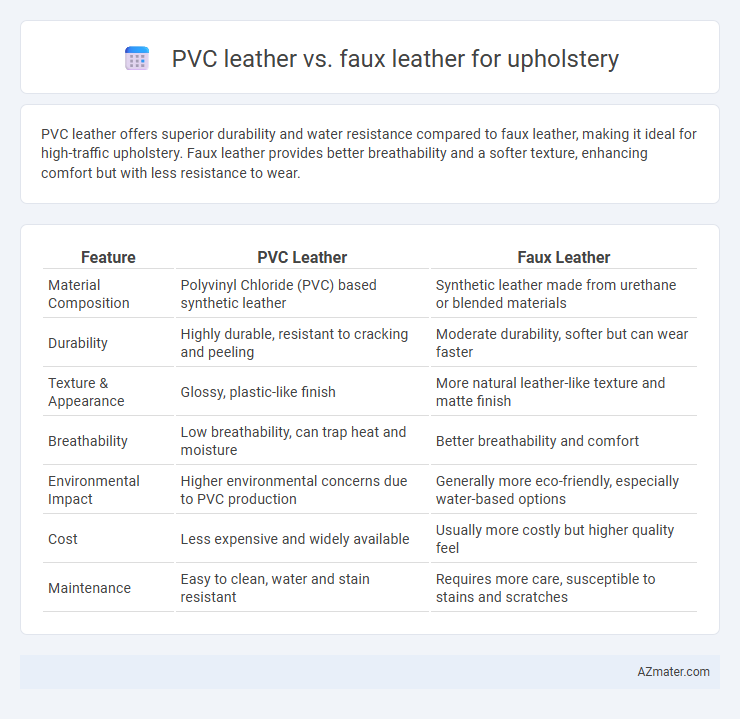PVC leather offers superior durability and water resistance compared to faux leather, making it ideal for high-traffic upholstery. Faux leather provides better breathability and a softer texture, enhancing comfort but with less resistance to wear.
Table of Comparison
| Feature | PVC Leather | Faux Leather |
|---|---|---|
| Material Composition | Polyvinyl Chloride (PVC) based synthetic leather | Synthetic leather made from urethane or blended materials |
| Durability | Highly durable, resistant to cracking and peeling | Moderate durability, softer but can wear faster |
| Texture & Appearance | Glossy, plastic-like finish | More natural leather-like texture and matte finish |
| Breathability | Low breathability, can trap heat and moisture | Better breathability and comfort |
| Environmental Impact | Higher environmental concerns due to PVC production | Generally more eco-friendly, especially water-based options |
| Cost | Less expensive and widely available | Usually more costly but higher quality feel |
| Maintenance | Easy to clean, water and stain resistant | Requires more care, susceptible to stains and scratches |
Introduction to PVC Leather and Faux Leather
PVC leather and faux leather are popular synthetic materials used for upholstery, offering affordable and durable alternatives to genuine leather. PVC leather, made from polyvinyl chloride coating on a fabric base, is known for its water resistance and ease of cleaning, making it ideal for high-traffic areas. Faux leather, typically crafted from polyurethane, provides a softer texture and greater breathability, closely mimicking the look and feel of real leather while being more environmentally friendly.
Composition and Manufacturing Process
PVC leather consists of a fabric base coated with polyvinyl chloride, created through a process of heating and plasticizing PVC resin combined with additives, resulting in a durable, waterproof material widely used in upholstery. Faux leather, often made from polyurethane (PU), involves applying a synthetic polymer coating onto a fabric substrate through a casting or lamination process, providing a softer, more flexible texture that closely mimics genuine leather. The manufacturing of PVC leather generally involves higher chemical content and a more rigid structure, whereas faux leather manufacturing emphasizes eco-friendly solvents and enhanced breathability.
Visual and Textural Differences
PVC leather for upholstery typically exhibits a shiny, uniform surface with a smooth texture, giving it a polished and synthetic look. Faux leather often mimics the natural grain and texture of genuine leather more closely, featuring subtle variations and a softer, more flexible feel. The visual distinction lies in PVC's artificial glossiness compared to faux leather's matte or semi-matte finish, which better replicates authentic leather aesthetics.
Durability and Longevity Comparison
PVC leather offers superior durability and resistance to wear compared to most faux leather alternatives, making it ideal for high-traffic upholstery applications. Faux leather, often made from polyurethane (PU), provides a softer texture but generally exhibits lower resistance to cracking and fading over time. PVC leather's robust construction and enhanced water and stain resistance contribute to a longer lifespan in furniture upholstery, ensuring sustained aesthetic appeal and functionality.
Comfort and Breathability Factors
PVC leather offers durability and water resistance but tends to be less breathable and can feel less comfortable during prolonged use due to its non-porous surface. Faux leather, often made from polyurethane (PU), provides better breathability and a softer touch, enhancing comfort for upholstery applications. Choosing faux leather can improve airflow and reduce heat buildup, making it a preferred option for seating areas that require extended comfort.
Environmental Impact and Sustainability
PVC leather, made from polyvinyl chloride, involves significant environmental concerns due to its production process releasing harmful dioxins and difficulty in recycling. Faux leather, often crafted from polyurethane, offers a lower environmental footprint with fewer toxic emissions and better biodegradability options. Both materials present sustainability challenges, but advancements in bio-based faux leather alternatives are enhancing eco-friendly upholstery solutions.
Maintenance and Cleaning Requirements
PVC leather for upholstery offers superior water resistance and durability, making maintenance straightforward with simple wiping of spills using a damp cloth. Faux leather, while visually appealing and softer, tends to absorb oils and stains more easily, requiring gentle cleaning with mild soap solutions and increased attention to avoid damage. Regular cleaning and prompt stain removal are essential for both materials to preserve their appearance and extend furniture lifespan.
Cost Analysis: PVC Leather vs. Faux Leather
PVC leather typically offers a more affordable option for upholstery compared to faux leather, with costs varying between $3 to $7 per yard versus $5 to $15 per yard for faux leather. The price difference is influenced by the manufacturing process, material durability, and aesthetic quality, with PVC being easier to produce at scale. Budget-conscious projects often favor PVC leather for its lower initial investment, while faux leather provides better long-term value due to enhanced texture and wear resistance.
Best Applications for Upholstery
PVC leather is highly durable, waterproof, and easy to clean, making it ideal for high-traffic upholstery applications such as restaurant seating and office furniture. Faux leather offers a softer, more breathable texture and greater flexibility, which suits residential furniture like sofas and armchairs where comfort is a priority. Both materials provide cruelty-free alternatives to genuine leather, but PVC leather excels in environments requiring stain resistance and heavy use.
Choosing the Right Material for Your Needs
PVC leather offers superior durability and water resistance, making it ideal for high-traffic upholstery and commercial use. Faux leather, often made from polyurethane, provides a more natural look and greater breathability, enhancing comfort in residential settings. Choosing between PVC and faux leather depends on factors like budget, aesthetic preference, and the specific demands of the usage environment.

Infographic: PVC leather vs Faux leather for Upholstery
 azmater.com
azmater.com